The equity markets have been losing strength and seeing steady correction albeit with temporary rebounds. We thought this was a good time to revisit our stock recommendations, Prime Stocks, and see if you can have averaging opportunities in them.
Here we have identified 3 stocks where you can now buy on dips. Make sure your allocation strategy is the same as you began with for these stocks, and you don’t go overboard. You can invest in one shot or in 2-3 phases depending on the size of your investment, as we think the volatility can last for some time.

Equitas Small Finance Bank
We recommended Equitas SFB on 18th Oct, 2021 on the belief that the pain associated with small business and small-ticket unsecured lending has bottomed out. In the subsequent quarter (Dec’21) these lenders saw revival on the back of robust disbursements and lower provisioning. While Equitas SFB also reported strong profit recovery, disbursements disappointed – as they declined over the preceding quarter.
Management attributed this to shifting their focus on collections. The stock has now corrected 15% since our recommendation due to both company specific and market specific factors. We believe this correction provides an opportunity to ADD this growth stock at an attractive valuation of < 1.5 times price to book value. The following factors aid such a strategy now:
- The SFB has been successful in building a robust deposit base with CASA at 51% at the end of Dec’21 and overall cost of funds at ~6.5%. This will enable it to handle any short to medium term pressures on the spreads and RoA, due to rise in cost of funds. The SFB has been one of the pioneers in mobilizing deposits through digital channels. Further, Equitas SFB has also concluded its QIP on 18th Feb, 2022 raising Rs. 550 crore. Shares were issued at Rs. 53.59 per share. This will further augment the capital adequacy ratio of the bank from ~22% at the end of Dec’21.
- Asset quality concerns seem to be abating for small business and small ticket unsecured lending, as the Omicron wave also didn’t cause material business disruption. Equitas SFB also reported sequential decline in NPAs, though marginal, during the Dec’21 quarter. Though there may be a slowdown in the March quarter, it is unlikely to impact collections. Rating agencies have also started revising their outlook for the low-ticket unsecured lenders citing that bad loans have been absorbed and the segment will see growth resuming from FY23.
- A recent report by a foreign brokerage points out to a total lending opportunity size of Rs. 7 lakh crore for SFBs. Equitas SFB is one of three SFBs that have scaled up in the last 5 years with presence predominantly in the South. Backed by the advantage of lower cost of funds and the expertise in lending to niche segments, it is well positioned for growth with broad-based recovery in the economy. Lower cost of funds also gives it an edge over NBFCs in the similar segments that it is competing with.
- Equitas SFB has also completed 5 Years of operations and has hence become eligible to apply for a Universal bank license by Sep’21. It is in the process of merging Equitas Holdings with itself in the first place and expect to complete it in the next 6 -9 months. Post that, it may apply for a Universal bank license. While this may not entail a major change in business model, it comes with advantages in terms of lower priority sector lending targets and lower capital adequacy requirements while enabling it to expand its products and services.
HDFC
The broader market fall and general disenchantment with financials has triggered a 16% fall in the HDFC’s stock price from our buy price. We believe this fall presents a good opportunity for investors to average their acquisition costs for this bluechip. Our original buy recommendation on HDFC was given in January 2021 at Rs 2747. We believe that the investment thesis for the housing finance leader has only strengthened with recent developments such as pandemic concerns receding and inflation and rising rates making a comeback. Three factors prompt us to reiterate our buy on HDFC at current levels.
- Individual home loan disbursements, HDFC’s bread and butter business, are showing strong traction post-Covid, while other lenders are struggling with sluggish credit offtake. HDFC’s individual loan disbursements grew by 48% in the April-December 2021 period year-on-year. The company is also focusing more on digital loan origination and faster approvals, with 89% of loan applications now through digital modes. 79% of its loan book is from individual home loans. Loans to MIG and LIG loans made up 56% of the loan book by December 2021. Though this segment is vulnerable to the discontinuation of government subsidies, this is likely to be made up by a pickup in offtake from the HIG segment and pent up housing demand resulting from Covid.
- With the pandemic effect receding and despite the standstill on NPA recognition being lifted, HDFC’s gross NPAs rose marginally to 2.32% by end December 2021 from 2% the September quarter, but credit costs were at 0.26% in the December 2021 quarter, the lowest in 3 years. Its Stage 2 and 3 assets have moderated to 7.8% of loan book from 9.2% in June 2021. The restructured book is at about 1.2% of advances, lower than peers.
- Intensifying competition from banks, NBFCs and newer players lending to the self-employed have exerted pressure on HDFC’s loan yields which have moderated from 8.99% in FY21 to 8.09% in the nine months of FY22. With cost of funds also moderating, HDFC’s loan spreads have dipped slightly from 2.29% over FY21 to 2.26% in the first nine months of 2021. NIMs at 3.6% and Capital Adequacy at 22.4% remained healthy. But we believe that the recent spike in short-term borrowing costs in the market are a blessing in disguise for HDFC. As a top rated borrower with access to public deposits, HDFC appears to be better-placed to keep funding costs low and manage loan spreads than other NBFCs vying for the home loan pie. Leading banks however may continue to pose a competitive threat.
- After applying a 30% holding company discount to HDFC’s stakes in its associates and subsidiaries, the current market value of these works out to about Rs 1010 per share. Excluding this from HDFC’s market price of Rs 2194 (as we write), its core business is being valued at under 1.8 times its standalone book value. Given that HDFC Bank, HDFC Life and HDFC AMC are also trading at depressed valuations currently, any re-rating of subsidiaries will add to the upside for the HDFC stock.
Mahanagar Gas Limited
The stock of Mahanagar Gas (MGL) has seen a 30% fall from our buy price of Rs 1091 over a year ago. We have been biding our time to give an ‘average’ call on the stock, as the steep price in gas price globally prompted this correction. MGL appears to have taken the maximum hit arising from this in the third quarter of 2021 and we think this may be the low point in earnings. The effect of more price hikes in the December quarter will likely start showing in the fourth quarter results.
Given below are the key reasons why we think the company can come out of its short-to-medium-term challenges:
Addressing higher gas cost
Even before the geopolitical tensions in Ukraine, low inventories owing to a cold winter and strong demand scenario had fueled spot gas prices. While MGL taps the domestic gas allocation under administered price mechanism (APM), in order to meet the shortfall in such allocation (arising from higher demand), MGL resorts to sourcing additional gas at market price. High market prices over the last few quarters have resulted in higher input gas and therefore dents in margins.
However, we think MGL is responding well to this situation by resorting to both gradual price hikes and by entering into term contracts for supply. It hiked prices of both its CNG and PNG (piped gas) four times in the December quarter and again once in January 2022. Besides this, it has entered into a mid-term contract for 18 months to lock into rates and meet increased demand.
It is important to note that the ability of MGL to pass price hikes is determined by both demand and alternative fuel pricing. On this count, the difference between CNG and petrol is currently at a whopping 66% in Mumbai. The same was 42% with diesel. While this may come down post Ukraine tension, there has traditionally been a not-less-than 20-30% arbitrage in favour of CNG, thus providing leeway for price hikes. In the PNG segment too, there has been a healthy price difference (PNG lower) of 20% on an average, compared with LNG cylinders, thus providing cushion.
Strong volume
MGL has been reporting strong volume right through FY22. For the nine months ending December 22, its sales volume increased 48% over the same period a year ago. This was powered by a 67% increase in its CNG volume. This jump in volume also provides confidence that the company can comfortably pass increasing costs.
EV concerns overdone
Talk of the ‘BEST’ state-run bus transport in Mumbai adding EV buses also dampened the stock of MGL. It is to be noted that unlike New Delhi, Maharashtra does not have a mandate for electric buses. According to the MGL management, BEST currently has 2400-odd CNG buses and these are unlikely to be replaced by EVs, primarily because the charging time (which is a few hours in the night) for EV makes it unviable to have them on the roads on time. In our view, CNG will co-exist with EV, threatening only the diesel buses. In fact, BEST plans to convert about 800 diesel buses to CNG and add 200 new CNG buses in the near term.
In the medium term, ongoing capex (the benefit of which will not flow through now), higher commission demanded by OMCs and the upcoming APM hike in April 2022 could continue to put some pressure on margins, although a jump from the December 2021 levels will be imminent. Still moderation in margins compared with FY21 can be expected, with margins settling at FY-19 to FY-20 levels.
At Rs 770, the stock is at 9.3 times its FY23 expected earnings; MGL is not to be viewed as a high growth play but rather as a steady long-term play with good dividend payouts.




7 thoughts on “3 Prime Stocks to average now”
Greetings of the day
Equitas small Financial bank stock price is on downward trend for a couple of weeks. Is there anything to worry about the fundamentals of this stock
This was due to management change. We are watching and do not have any reason to worry for now. thanks, Vidya
Equitas Small Finance Bank: The bank’s asset quality has deteriorated in the recent past, as indicated by the following figures (All in Rs/Crores).
December 2020 December 2021
Gross NPA 387 863
Gross NPA % 2.27 4.61
Net NPA 130 459
Net NPA% 0.67 2.51
Appreciate, if you could provide reasons and mitigations, if any, for the decline in asset quality.
Further, I could not find quarterly performance update on the recommended stocks. Please look into it.
Regards,
Venkatesh
Welcome your query sir
We have mentioned in detail in our report about how Equitas became a small finance bank, its loan book composition, restructured loans and the challenges it faces in the post Covid environment
Small finance banks and micro-finance institutions are the last to recover from the impact of Covid as they lend to low income and self employed category
Our call was based on the belief that the worst is over for SFBs and they were entering a recovery phase. Post 2nd wave of Covid there have been NO disruptions to mobility or business activities.
For Equitas, gross NPA has declined in December quarter compared to preceding quarter (Sept) while March quarter will give further clarity on recovery/ growth. Much of the NPA reduction will happen with economic recovery while management is also laying focus on collections and disbursements.
Worst seem to be over (NPA peak out), recovery is happening (collections getting back to normal, NPA declining) while growth (loan disbursement and profit) will pick up with full blown recovery in the semi-urban/rural economy.
Hope this clarifies your query
Unless there is anything material to communicate, we don’t come up with quarterly result updates
Thank you
How about Engineers India? It is down 21% since it was recommended…
“MGL is not to be viewed as a high growth play but rather as a steady long-term play with good dividend payouts.”
In the stock recommendation tool, Mahanagar Gas Limited carries an ‘Earnings Compounder’ label but this article ends with a case being made for it as a moderate growth option in the long-term with dividend payouts. Could you please clarify if there’s been a change in stance indicating that MGL is now a better dividend option, or do you feel it also still warrants the label it’s been assigned in the recommendation tool? (considering there’s a ‘Dividend Earner’ label too that hasn’t been assigned to this stock). Thanks.
If you kindly see our classification explanation, you will specifically see the text: “These companies can build wealth through steady moderate earnings growth. There is a separate category called ‘high growth’ where we expect earnings to grow at a very fast pace in the next 2-3 years. This is not one of them. thanks Vidya
Comments are closed.